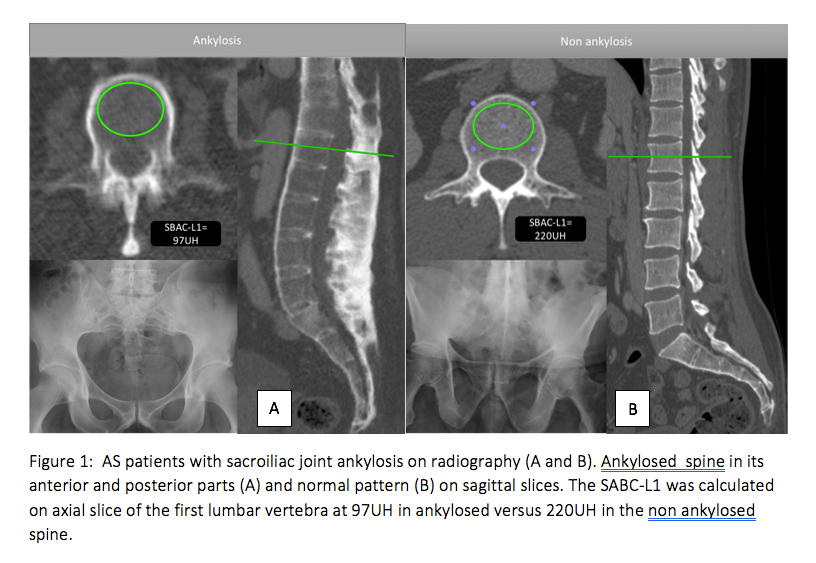Session Information
Session Type: Poster Session (Monday)
Session Time: 9:00AM-11:00AM
Background/Purpose: Spine ankylosis is a risk factor of osteoporosis and mortality in ankylosing spondylitis (AS). Recently, thoracic-abdomino-pelvic CT (TAP-CT) has demonstrated its ability to screen bone fragility through the scanographic bone attenuation coefficient of the first lumbar vertebra (SBAC-L1). CT-scans is a remarkable imaging technic to assess structural spine ankylosis and vertebral fractures (VF). Our objectives are to assess the association between the SBAC-L1 and spine structural lesions on CT and to determine both VF prevalence and percentage of AS patients under the fracture threshold (SBAC-L1 ≤ 145 HU).
Methods: On 1503 consecutive SpA patients followed from 2009 to 2017 at Nancy University hospital, only patients responding to New York criteria for AS and explored by a TAP-CT scan and X-rays (XR, spine, pelvis) within 2 years were included. Demographic and clinical characteristics were collected. CT spine structural lesions were assessed by two readers on erosions, syndesmophytes and ankylosis for the anterior part and on ankylosis for the posterior part (facet joints) from C7 to S1 vertebrae. mSASSS and anterior, posterior and total (anterior +posterior) ankylosing CT spine scores ranged from 0-72, 0-108, 0-108, and 0-216 respectively. The SBAC-L1 value under ≤ 145 HU defined the fracture threshold.
Results: 67 AS patients were included (median age: 61.2 years, 89% men, 59.7% HLAB27 +, NSAIDs 67.2% and TNF-i 58.2%). All patients presented sacroiliitis on XR and the mean mSASSS was 14.7±17.5. The mean anterior, posterior and total ankylosing CT spine scores were 32.4±39.9, 27±40.9 and 63.7±82, respectively. Ankylosing CT spine scores were highly reproducible (ICC >0.97; Kappa: 0.60-1). No CT structural lesion was observed in 27 patients (45%). Spine Ankylosis was depicted in 38 patients (56.7%). Exclusive anterior or posterior vertebral ankylosis was observed in 8 (11.9%) and 5 (7.4%) patients respectively and both parts in 25 patients (37.3%). The total ankylosing CT spine scores presented good correlations with the mSASSS (r=0.76 (0.60-0.87)). On CT, VFs (n=9) were detected in 5 patients (7.5%). The mean SBAC-L1 was 135.7 HU (±49.2) and 40 patients (59.7%) were under the fracture threshold. For the 5 patients with VFs, 4 patients had a SBAC-L1 ≤ 145UH and 3 of them presented spine ankylosis. We showed an inverse correlation between SBAC-L1 and anterior ankylosing CT spine score (r=-0,40; p≤0,01), with similar level of correlation for the two other scores. AS patients with spine ankylosis (anterior, posterior or both) presented more frequently a SBAC-L1 ≤145UH (p≤0.012).
Conclusion: we showed an inverse correlation between SBAC-L1 and total ankylosing CT spine score (r=-0,401; p≤0,01). AS patients with anterior and/or posterior vertebral ankylosis on CT-scans are more frequently under the fracture threshold for the SABC-L1. Four out of five AS patients with VF (prevalence: 7.4%) were under a SABC-L1≤145UH.
To cite this abstract in AMA style:
Morizot c, Fauny M, Allado E, Verhoeven F, Albuisson E, Pinzano-Watrin A, Chary-Valckenaere I, Loeuille D. To Evaluate Spine Ankylosis, Vertebral Fractures and Bone Fragility on a Single Imaging Exam in Patients with Ankylosing Spondylitis: Myth or Reality? [abstract]. Arthritis Rheumatol. 2019; 71 (suppl 10). https://acrabstracts.org/abstract/to-evaluate-spine-ankylosis-vertebral-fractures-and-bone-fragility-on-a-single-imaging-exam-in-patients-with-ankylosing-spondylitis-myth-or-reality/. Accessed .« Back to 2019 ACR/ARP Annual Meeting
ACR Meeting Abstracts - https://acrabstracts.org/abstract/to-evaluate-spine-ankylosis-vertebral-fractures-and-bone-fragility-on-a-single-imaging-exam-in-patients-with-ankylosing-spondylitis-myth-or-reality/

